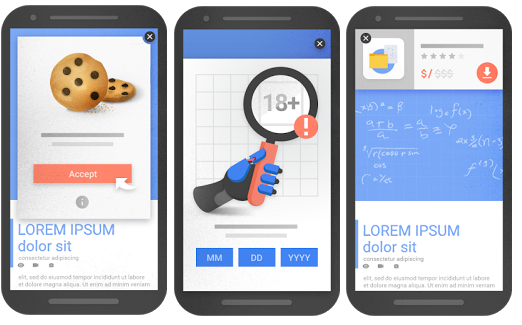Interstitial ads or obstructive banner ads will have to evolve for easy accessibility of mobile content. Google announced that by Jan 10, 2017, they will not entertain sites that interrupt the user accessibility of site/app content, especially the mobile version.
Interstitial ads are full-screen ads that cover most of the screen space of host app, or mobile sites. In apps, these ads are displayed at various transition points, whereas in mobile sites it pops up as the web page loads. In the beginning, this ad feature was considered to be a real boon for the advertisers, as it utilizes maximum screen space, and many thought that it was better than banner ads.
What might have gone wrong?
Why do you think Google considered the penalization on interstitial ads? Is it Google’s plan to take vengeance towards those who took a step back in the case of Chrome OS, as some refer it to be, or is the sole reason, to make mobile users free of annoying ads? As always, when someone finds a new opportunity to rank sites, there will be few to overdo it .
As a mobile user, while using an app, or browsing through a site, we do come across such ads. Some have a friendly interface and we can easily ignore it. Whereas some ads, which I’m sure many might have come across, will pop up when we might be doing something important in an app and obstruct the site main content. The most annoying part is that some won’t even have a close or exit option, and only way out is, to sit through it.
Google update: Make your website mobile friendly
Advertisers are the ones who should think it through. They are the ones who might need to look back on their ad strategy and identify what went wrong? Where did they cross the line?
According to Doantam Phan, pages that show intrusive interstitials provide a poor experience to users than other pages where content is easily accessible. This can be problematic on mobile devices where screens are often smaller. From the beginning of the new year, sites that do not qualify the quality of ads might have to face penalization by Google.
This announcement is not a surprise, as in 2015 Google had already announced that mobile sites that showed app installation ads, rather than the site content, will be penalized. Now Google just took that update to larger perspective in order to make better mobile usage.
How to be on the safer side?

In short, BE RESPONSIBLE. Ads that does not affect the accessibility of the main content of a web page or app, need not have to fear the new signal change in January 2017. Interstitials for cookie usage, age verification, and also banners that use only a reasonable screen space etc. are always on the safe side.
Again, those who have been advertising responsibly and with quality, need not be concerned of the new signals, and this is the same with all the other ranking factors. Too much of something is always .

